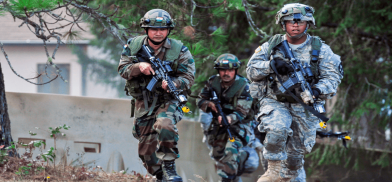A strategic shift? Lessons for India from the Dragon's Taiwan fury
It will be for the first time that the Pentagon is getting involved in a high-altitude exercise with Indian troops, a fact that will not go unnoticed in Beijing. Is staging these combat drills so close to the disputed region indicative of a strategic shift on the part of New Delhi?

Reacting to India’s protests, Sri Lanka recently delayed permission for Yuan Wang 5, one of China’s latest generation space-tracking ships with suspected spying capabilities, to dock at the port of Hambantota, situated only 450 km from Kanyakumari, the southernmost tip of India. But that decision was short-lived. Within days, Colombo reversed it, obviously yielding to Chinese pressure. It speaks volumes about Beijing’s influence in India’s immediate neighbourhood as well as the Dragon’s maritime reach well beyond the South China Sea.
Meanwhile, opposition Congress leader Rahul Gandhi’s recent endorsement of a new book (The Last War: How AI Will Shape India’s Final Showdown with China), which claims that in the event of a war China could defeat India in just 10 days and even annex Arunachal Pradesh and Ladakh, has helped draw attention to the wide gap in defence capabilities between the two nuclear-armed neighbours.
After a brief interregnum of a unipolar world following the fall of the Berlin Wall, now there is a new kid on the block - China. Under its ambitious leader Xi Jinping, an assertive China is demanding a stake in global leadership. Beijing is determined to question the existing world order and rewrite the rules of technology and the norms of international institutions.
Pelosi visit
China exploited US House Speaker Nancy Pelosi’s recent visit to Taiwan to showcase its growing military prowess with the People’s Liberation Army (PLA) conducting several days of military drills around Taiwan. For the first time, China launched ballistic missiles over Taiwan’s capital city Taipei, thus crossing a red line and setting a “new normal”. Chinese warships and drones simulated attacks on the US and Japanese warships off Taiwan’s east coast and close to Japanese islands, drawing condemnation from US officials and even Australia and Japan.
The mock drills that followed Pelosi’s visit have left the PLA better prepared in case of a war with Taiwan. According to the New York Times, American and Taiwanese officials now believe China used the Pelosi visit as “a pretext to step up its operations to intimidate Taiwan for months or years to come, and perhaps speed the timetable of its plans to establish control over the island’s 23 million people, much as it did in Hong Kong.”
China now has the economic clout, military capability and technological sophistication, particularly in the area of artificial intelligence (AI), to take on the United States for leadership in the Indo-Pacific region and even beyond. Going by Beijing’s rhetoric, China will not hesitate to employ military means to achieve its strategic objectives. Many analysts believe that the Dragon is keenly watching the Ukraine war to draw lessons for its own possible adventures in the future, against Taiwan and beyond.
India front
Following the military reforms that began in 2016, PLA’s five theatre commands are structured based on threat perceptions facing China’s specific border areas. The Western Theatre Command, the largest of the five, directly faces India, focusing on the Line of Actual Control (LAC) as well as Tibet and Xinjiang.
A recent report by Gateway House think tank says that the military reforms and modernisation of the PLA have strengthened China’s coercive capabilities. “The reforms give the PLA the ability to fight decisive wars, and in some cases as cyber, cripple the enemy without firing a shot. This adds to the already large power differential between the Chinese military and other regional militaries, including India,” it says.
After maintaining a long “studied” silence over China’s show of military might around Taiwan over Pelosi’s visit, Indian External Affairs Ministry spokesperson Arindam Bagchi expressed concern over the recent developments and urged “exercise of restraint” and de-escalation of tensions. Such dithering is in tune with the Narendra Modi government’s China policy, which is dictated by domestic political compulsions.
Chinese occupation
For instance, no political leader, including the Prime Minister or the Defence Minister, has till today explained to the nation what exactly transpired during the standoff with China at the Line of Actual Control in 2020. New Delhi is yet to publicly acknowledge that China illegally occupies Indian territory in Ladakh, Arunachal Pradesh and elsewhere across the LAC.
Since the 2020 skirmishes in Galwan Valley that led to the death of 20 Indian soldiers, India’s approach to the border disputes with China has been characterized by a lack of acknowledgment that is widely seen as appeasement. There has neither been any substantial discussion in Parliament on the border tensions nor has the Parliamentary Standing Committee on Defence issued any public statements on the situation.
Meanwhile, all eyes are now set on the annual India-US military exercises, called Yudh Abhyas, scheduled to take place in October in Uttarakhand’s Auli, less than 100 km from the Line of Actual Control (LAC) with China. It will be for the first time that the Pentagon is getting involved in a high-altitude exercise with Indian troops, a fact that will not go unnoticed in Beijing. Is staging these combat drills so close to the disputed region indicative of a strategic shift on the part of New Delhi? What will be China’s reaction to the Himalayan drills in comparison to its Taiwan fury?
Whether the upcoming high-altitude military exercise alongside US troops is the beginning of a more robust policy toward China’s aggressive stance against India is anybody’s guess. But if there is one lesson for India to learn from the Taiwan crisis, it’s that the hitherto head-in-the-sand approach towards the Dragon is untenable and a threat to national security.
(The author, a former spokesperson with the United Nations, is a political and diplomatic observer. Views are personal. He can be reached @edmathew on Twitter)










Post a Comment